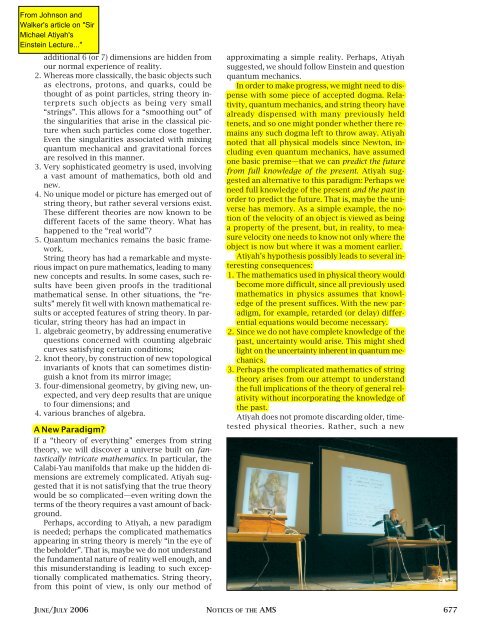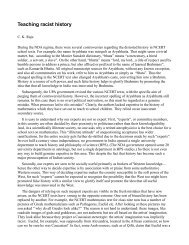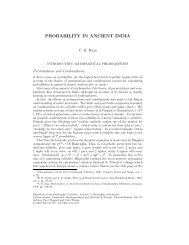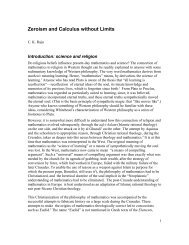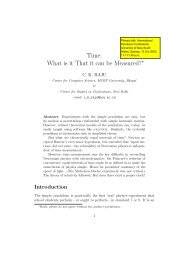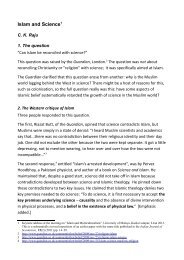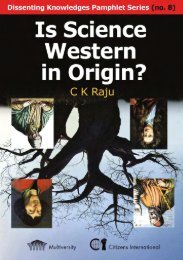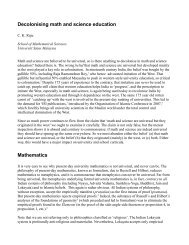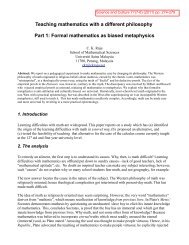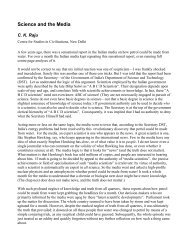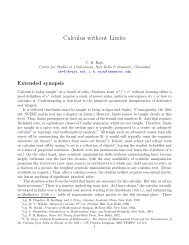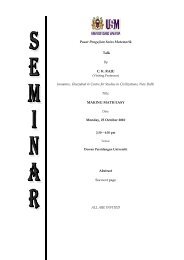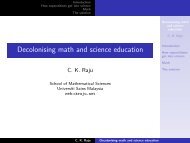Notices of the AMS - CK Raju
Notices of the AMS - CK Raju
Notices of the AMS - CK Raju
You also want an ePaper? Increase the reach of your titles
YUMPU automatically turns print PDFs into web optimized ePapers that Google loves.
additional 6 (or 7) dimensions are hidden fromour normal experience <strong>of</strong> reality.2. Whereas more classically, <strong>the</strong> basic objects suchas electrons, protons, and quarks, could bethought <strong>of</strong> as point particles, string <strong>the</strong>ory interpretssuch objects as being very small“strings”. This allows for a “smoothing out” <strong>of</strong><strong>the</strong> singularities that arise in <strong>the</strong> classical picturewhen such particles come close toge<strong>the</strong>r.Even <strong>the</strong> singularities associated with mixingquantum mechanical and gravitational forcesare resolved in this manner.3. Very sophisticated geometry is used, involvinga vast amount <strong>of</strong> ma<strong>the</strong>matics, both old andnew.4. No unique model or picture has emerged out <strong>of</strong>string <strong>the</strong>ory, but ra<strong>the</strong>r several versions exist.These different <strong>the</strong>ories are now known to bedifferent facets <strong>of</strong> <strong>the</strong> same <strong>the</strong>ory. What hashappened to <strong>the</strong> “real world”?5. Quantum mechanics remains <strong>the</strong> basic framework.String <strong>the</strong>ory has had a remarkable and mysteriousimpact on pure ma<strong>the</strong>matics, leading to manynew concepts and results. In some cases, such resultshave been given pro<strong>of</strong>s in <strong>the</strong> traditionalma<strong>the</strong>matical sense. In o<strong>the</strong>r situations, <strong>the</strong> “results”merely fit well with known ma<strong>the</strong>matical resultsor accepted features <strong>of</strong> string <strong>the</strong>ory. In particular,string <strong>the</strong>ory has had an impact in1. algebraic geometry, by addressing enumerativequestions concerned with counting algebraiccurves satisfying certain conditions;2. knot <strong>the</strong>ory, by construction <strong>of</strong> new topologicalinvariants <strong>of</strong> knots that can sometimes distinguisha knot from its mirror image;3. four-dimensional geometry, by giving new, unexpected,and very deep results that are uniqueto four dimensions; and4. various branches <strong>of</strong> algebra.A New Paradigm?If a “<strong>the</strong>ory <strong>of</strong> everything” emerges from string<strong>the</strong>ory, we will discover a universe built on fantasticallyintricate ma<strong>the</strong>matics. In particular, <strong>the</strong>Calabi-Yau manifolds that make up <strong>the</strong> hidden dimensionsare extremely complicated. Atiyah suggestedthat it is not satisfying that <strong>the</strong> true <strong>the</strong>orywould be so complicated—even writing down <strong>the</strong>terms <strong>of</strong> <strong>the</strong> <strong>the</strong>ory requires a vast amount <strong>of</strong> background.Perhaps, according to Atiyah, a new paradigmis needed; perhaps <strong>the</strong> complicated ma<strong>the</strong>maticsappearing in string <strong>the</strong>ory is merely “in <strong>the</strong> eye <strong>of</strong><strong>the</strong> beholder”. That is, maybe we do not understand<strong>the</strong> fundamental nature <strong>of</strong> reality well enough, andthis misunderstanding is leading to such exceptionallycomplicated ma<strong>the</strong>matics. String <strong>the</strong>ory,from this point <strong>of</strong> view, is only our method <strong>of</strong>approximating a simple reality. Perhaps, Atiyahsuggested, we should follow Einstein and questionquantum mechanics.In order to make progress, we might need to dispensewith some piece <strong>of</strong> accepted dogma. Relativity,quantum mechanics, and string <strong>the</strong>ory havealready dispensed with many previously heldtenets, and so one might ponder whe<strong>the</strong>r <strong>the</strong>re remainsany such dogma left to throw away. Atiyahnoted that all physical models since Newton, includingeven quantum mechanics, have assumedone basic premise—that we can predict <strong>the</strong> futurefrom full knowledge <strong>of</strong> <strong>the</strong> present. Atiyah suggestedan alternative to this paradigm: Perhaps weneed full knowledge <strong>of</strong> <strong>the</strong> present and <strong>the</strong> past inorder to predict <strong>the</strong> future. That is, maybe <strong>the</strong> universehas memory. As a simple example, <strong>the</strong> notion<strong>of</strong> <strong>the</strong> velocity <strong>of</strong> an object is viewed as beinga property <strong>of</strong> <strong>the</strong> present, but, in reality, to measurevelocity one needs to know not only where <strong>the</strong>object is now but where it was a moment earlier.Atiyah’s hypo<strong>the</strong>sis possibly leads to several interestingconsequences:1. The ma<strong>the</strong>matics used in physical <strong>the</strong>ory wouldbecome more difficult, since all previously usedma<strong>the</strong>matics in physics assumes that knowledge<strong>of</strong> <strong>the</strong> present suffices. With <strong>the</strong> new paradigm,for example, retarded (or delay) differentialequations would become necessary.2. Since we do not have complete knowledge <strong>of</strong> <strong>the</strong>past, uncertainty would arise. This might shedlight on <strong>the</strong> uncertainty inherent in quantum mechanics.3. Perhaps <strong>the</strong> complicated ma<strong>the</strong>matics <strong>of</strong> string<strong>the</strong>ory arises from our attempt to understand<strong>the</strong> full implications <strong>of</strong> <strong>the</strong> <strong>the</strong>ory <strong>of</strong> general relativitywithout incorporating <strong>the</strong> knowledge <strong>of</strong><strong>the</strong> past.Atiyah does not promote discarding older, timetestedphysical <strong>the</strong>ories. Ra<strong>the</strong>r, such a newJUNE/JULY 2006 NOTICES OF THE <strong>AMS</strong> 677
paradigm ought to build on <strong>the</strong> old <strong>the</strong>ories, muchas relativity builds on Newtonian mechanics.Speculations and QuestionsThere are various attitudes among physicists towardstring <strong>the</strong>ory. Some dismiss it as fancy ma<strong>the</strong>maticsthat is unrelated to <strong>the</strong> real world, sincestring <strong>the</strong>ory makes no testable predictions. O<strong>the</strong>rsbelieve <strong>the</strong> ma<strong>the</strong>matical applications <strong>of</strong> string<strong>the</strong>ory give confidence in <strong>the</strong> physical insights andindicate that <strong>the</strong> <strong>the</strong>ory is on <strong>the</strong> right track. Fromthis point <strong>of</strong> view, ma<strong>the</strong>matical applications becomea kind <strong>of</strong> alternative to experimental evidence.A third point <strong>of</strong> view is that we should continueto push forward with string <strong>the</strong>ory in <strong>the</strong> hopethat <strong>the</strong> new results and ideas that emerge will serveas a guide for finding a final unified <strong>the</strong>ory.Atiyah concluded his talk by speculating on <strong>the</strong>meaning <strong>of</strong> all this—quantum field <strong>the</strong>ory, string<strong>the</strong>ory, and <strong>the</strong>ir ma<strong>the</strong>matical applications. Whatwill <strong>the</strong> future physical <strong>the</strong>ory look like? The aimis to unify quantum mechanics, <strong>the</strong> physics <strong>of</strong> <strong>the</strong>very small, with general relativity, <strong>the</strong> physics <strong>of</strong><strong>the</strong> very large. Supersymmetry is a symmetry inwhich physical laws are unchanged when bosonsand fermions are interchanged. Superstring <strong>the</strong>ory,a supersymmetric string <strong>the</strong>ory, is a perturbativeapproach, one that Atiyah compared with <strong>the</strong> <strong>the</strong>ory<strong>of</strong> epicycles developed by Ptolemy. But what is<strong>the</strong> real <strong>the</strong>ory; that is, what is being perturbed? Isit M-<strong>the</strong>ory, a currently incomplete <strong>the</strong>ory unifyingall five versions <strong>of</strong> string <strong>the</strong>ory? Is <strong>the</strong> universereally built using all this sophisticated machineryor is this an example <strong>of</strong> ma<strong>the</strong>matics imposed byus? Perhaps <strong>the</strong> real physics is simpler and oneshould adhere to <strong>the</strong> dictate <strong>of</strong> Occam’s razor—conceptsshould not be multiplied beyond necessity.Do we need to modify quantum mechanics? Atiyahclosed by saying “This is for young people: Goaway and explore it. If it works, don’t forget I suggestedit. If it doesn’t, don’t hold me responsible.”The second Einstein Public Lecture in Ma<strong>the</strong>maticswas delivered on April 29, 2006, in conjunctionwith <strong>the</strong> <strong>AMS</strong> Spring Western SectionalMeeting at San Francisco State University. BenoîtMandelbrot <strong>of</strong> Yale University spoke on “The nature<strong>of</strong> roughness in ma<strong>the</strong>matics, science, and art”.All photographs used in this article are courtesy<strong>of</strong> Gregg Johnson (Suitefreedom.com).678 NOTICES OF THE <strong>AMS</strong> VOLUME 53, NUMBER 6


